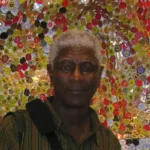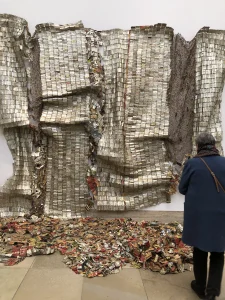An artist firmly rooted in his geographical surroundings, El Anatsui’s works often emerge from this physicality with locally sourced materials. Indeed, many of his works, such as his elaborate metal weavings, are constructed from local object trouvé ranging from bottle tops, wrapping paper and other detritus that he comes across on road-side dumps in Nigeria. He critiques the contemporary by rediscovering traditional Ghanaian motifs and aesthetic devices.
One of Anatsui's most celebrated bodies of work, the 'cloth series', has been likened to a variation of the Ghanaian kente cloth, a popular cloth which is defined by its colourful strip-pattern. To create the pieces, Anatsui gathers hundreds of liquor-bottle tops and painstakingly flattens and pierces them in order to weave them together with copper wire. The result is wonderful web of muted golds and reds which are woven together in fanciful, traditional patterns. It has been noted that Anatsui's unique choice of material and form represents a decisive commentary on the role of both liquor and cloth in the European slave trade on the West African coast and that his use of recycled materials may allude to the death and re-birth experienced by post-colonial countries.
Anatsui was born in 1944, in Anyako, Ghana and trained at the College of Art, University of Science and Technology, in Kumasi. He began teaching at the University of Nigeria, Nsukka, in 1975. Anatsui’s works have been collected by major international museums, including British Museum, London; Centre Pompidou, Paris; de Young Museum, San Francisco; Smithsonian Institution, Washington; museum Kunst Palast, Düsseldorf and Guggenheim, Abu Dhabi.
His works have been exhibited all over the world, most notably the Smithsonian National Museum of African Art, Washington; Royal Ontario Museum, Toronto; Bass Museum of Art, Miami; Des Moines Art Center, Iowa; Akron Art Museum, Ohio; Museum of Contemporary Art San Diego, California; and Brooklyn Museum, New York. In 2013, Anatsui received the prestigious Charles Wollaston Award and was awarded the Golden Lion for Lifetime Achievement at the 56th Venice Biennale.
Anatsui lives and works between Ghana and Nigeria.
One of Anatsui's most celebrated bodies of work, the 'cloth series', has been likened to a variation of the Ghanaian kente cloth, a popular cloth which is defined by its colourful strip-pattern. To create the pieces, Anatsui gathers hundreds of liquor-bottle tops and painstakingly flattens and pierces them in order to weave them together with copper wire. The result is wonderful web of muted golds and reds which are woven together in fanciful, traditional patterns. It has been noted that Anatsui's unique choice of material and form represents a decisive commentary on the role of both liquor and cloth in the European slave trade on the West African coast and that his use of recycled materials may allude to the death and re-birth experienced by post-colonial countries.
Anatsui was born in 1944, in Anyako, Ghana and trained at the College of Art, University of Science and Technology, in Kumasi. He began teaching at the University of Nigeria, Nsukka, in 1975. Anatsui’s works have been collected by major international museums, including British Museum, London; Centre Pompidou, Paris; de Young Museum, San Francisco; Smithsonian Institution, Washington; museum Kunst Palast, Düsseldorf and Guggenheim, Abu Dhabi.
His works have been exhibited all over the world, most notably the Smithsonian National Museum of African Art, Washington; Royal Ontario Museum, Toronto; Bass Museum of Art, Miami; Des Moines Art Center, Iowa; Akron Art Museum, Ohio; Museum of Contemporary Art San Diego, California; and Brooklyn Museum, New York. In 2013, Anatsui received the prestigious Charles Wollaston Award and was awarded the Golden Lion for Lifetime Achievement at the 56th Venice Biennale.
Anatsui lives and works between Ghana and Nigeria.

 Back
Back









